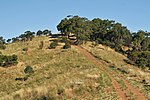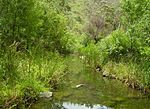Torrens Linear Park

The Torrens Linear Park was completed in 1997 as the first of its kind developed in Australia where it is the largest hills-to-coast park. It began as a flood mitigation scheme along the River Torrens running westward from the Adelaide Hills, through the Adelaide metropolitan area, to the sea. Cyclists and walkers can use a trail that runs the 30 km (19 mi) length of the park, from Gorge Road, in Athelstone in the north-east, through the Northern Parklands of the City of Adelaide, to the river mouth at Henley Beach in the west. In the Parklands section, the river runs past many notable landmarks including the Adelaide Zoo, the Adelaide Botanic Gardens, the Festival Theatre and Elder Park. There are shared-use pedestrian and cycling paths along both sides of the river for most of the length of the park, and along one side of the O-Bahn Busway.
Excerpt from the Wikipedia article Torrens Linear Park (License: CC BY-SA 3.0, Authors, Images).Torrens Linear Park
Gorge Road, Adelaide Athelstone
Geographical coordinates (GPS) Address Nearby Places Show on map
Geographical coordinates (GPS)
| Latitude | Longitude |
|---|---|
| N -34.86 ° | E 138.72 ° |
Address
Gorge Road
Gorge Road
5076 Adelaide, Athelstone
South Australia, Australia
Open on Google Maps







